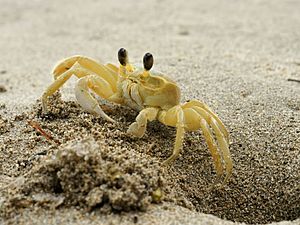Atlantic ghost crab facts for kids
Quick facts for kids Atlantic ghost crab |
|
|---|---|
 |
|
| Adult O. quadrata by a burrow entrance | |
 |
|
| Juvenile O. quadrata | |
| Scientific classification | |
| Kingdom: | |
| Phylum: | |
| Subphylum: | |
| Class: | |
| Order: | |
| Infraorder: | |
| Family: |
Ocypodidae
|
| Genus: |
Ocypode
|
| Species: |
O. quadrata
|
| Binomial name | |
| Ocypode quadrata (Fabricius, 1787)
|
|
| Synonyms | |
|
|
The Atlantic ghost crab, Ocypode quadrata, is a type of ghost crab. You can find it often along the Atlantic coast of the United States. It's the only ghost crab species there. Its home stretches from beaches in Westport, Massachusetts, all the way south to Brazil. You can find it as far south as Barra do Chui in Rio Grande do Sul.
Contents
About the Atlantic Ghost Crab
Adult Atlantic ghost crabs are usually grey or a straw color. They grow to be about 5 centimeters (2 inches) wide. These crabs need to go back to the water sometimes to keep their gills wet. When they are very young, called larvae, they must be released into the sea. But for most of their lives, they live on land.
Their eyes are on stalks and can turn all around. This gives them a full 360-degree view! Young crabs have colors that help them blend in with the sand. This makes them hard to spot.
Where They Live
Atlantic ghost crabs live from Block Island, Rhode Island, and Nantucket, Massachusetts, down to Santa Catarina, Brazil. They are also found on Fernando de Noronha and in Bermuda. Their tiny planktonic larvae can travel even farther north. They have been found near Woods Hole, Massachusetts. However, adult crabs cannot survive in those colder places.
Ancient Crabs
Scientists have found fossils of O. quadrata in rocks. These rocks are from the Pleistocene time period. This means these crabs have been around for a very long time!
How They Live and What They Do
Atlantic ghost crabs dig burrows in the sand. They usually make their homes above the high tide line. Older crabs dig their burrows farther from the sea. Some can dig as far as 400 meters (1,300 feet) inland. Their burrows can be up to 1.3 meters (4 feet) deep. When it gets very hot, they can close off their burrows with sand.
These crabs can make different sounds. They might hit the ground with their claw. They can also rub their legs together to make a sound, which is called stridulation. They also make a "bubbling sound" that scientists don't fully understand yet. Male crabs will compete with each other in special ways. This helps them avoid actually fighting.
O. quadrata crabs are more active at night than during the day. They are omnivores, which means they eat many different things. They munch on clams, insects, plants, and even other crabs. They also eat detritus, which is decaying bits of plants and animals.
Sadly, the number of ghost crabs on sandy beaches has gone down. This is because of human activities. When people and vehicles walk or drive on the beach, they can accidentally crush crabs. This also squishes the sand, making it harder for crabs to live there. Human activities can also make it difficult for crabs to have babies. Too much light at night from human areas can also bother them. Because of these reasons, you won't see as many ghost crabs on beaches where lots of people go.
See also
 In Spanish: Cangrejo fantasma del Atlántico para niños
In Spanish: Cangrejo fantasma del Atlántico para niños


